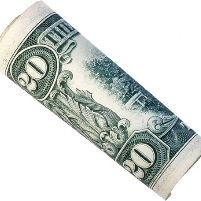90% of U.S. Paper Money Has Traces of Cocaine
Tuesday, August 18, 2009

America’s currency has a coke problem. A sampling of U.S. paper money from across the country revealed 90% contained trace amounts of cocaine, presumably from users’ habit of rolling up greenbacks to snort the drug.
Researchers from the University of Massachusetts Dartmouth examined 234 bills, ranging in denomination from $5 to $50, from 18 cities and found Washington, DC (95%), Baltimore, Boston and Detroit had the highest concentration of contaminated currency. The U.S. city with the lowest amount was Salt Lake City. The data indicated that the bills of choice among users are $5s, $10s and $20s, while $1’s had fewer coke particles on them.
Researchers also tested currencies from other nations. Eighty-five percent of Canada’s revealed some level of contamination, while 80% of Brazil’s also bore traces of the drug. The levels were considerably lower in Asian countries. China’s only had 20% and Japan’s 12%.
It is worth keeping in mind that many of the bills may not have actually been used for snorting cocaine, but rather they may have been contaminated by coming in contact with other bills in ATMs and counting machines.
-Noel Brinkerhoff
Cocaine Contaminates Majority of U.S. Currency (by David Biello, Scientific American)
Drugged Money (by Janet Raloff, Science News)
- Top Stories
- Unusual News
- Where is the Money Going?
- Controversies
- U.S. and the World
- Appointments and Resignations
- Latest News
- Musk and Trump Fire Members of Congress
- Trump Calls for Violent Street Demonstrations Against Himself
- Trump Changes Name of Republican Party
- The 2024 Election By the Numbers
- Bashar al-Assad—The Fall of a Rabid AntiSemite






Comments